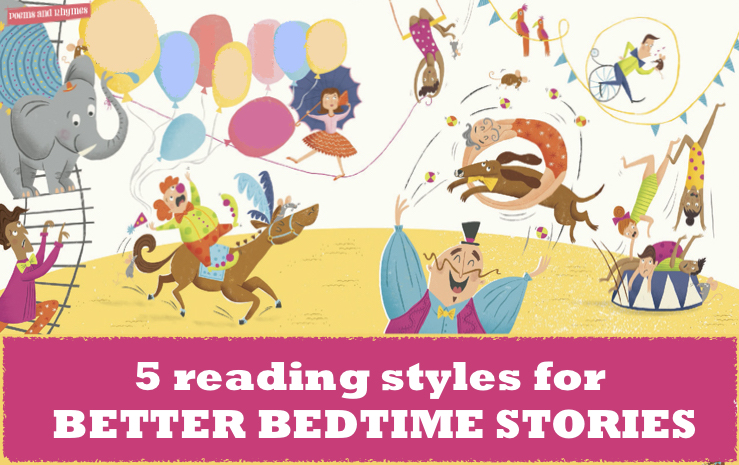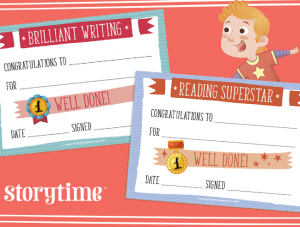 Does your child hate bedtime stories? The traditional way to share stories with your children is to sit beside them, book perched on your lap – maybe open across both of your laps – and to read aloud. You put on your best funny voices (or not) and point at key words and pictures. Perhaps you speed up and slow down in all the right places. (We’ve covered traditional reading techniques here.)
Does your child hate bedtime stories? The traditional way to share stories with your children is to sit beside them, book perched on your lap – maybe open across both of your laps – and to read aloud. You put on your best funny voices (or not) and point at key words and pictures. Perhaps you speed up and slow down in all the right places. (We’ve covered traditional reading techniques here.)
But what if the traditional way isn’t working? What if it isn’t holding your child’s attention? Instead of the magical ‘together time’ you’d hoped for, you have a bored, wriggling audience? For some children, being read aloud to – no matter how good you think the story is – can be a monotonous experience. It can feel too passive for an active young mind.
If this is the case, don’t worry and certainly don’t give up. There are other reading styles that might be the key to engaging your child (or children in your class) with reading. In fact, these different styles might help your child develop a lifelong love of stories and books.
At your next Storytime session, why not have a go at these alternative reading styles?
5 Reading Styles to Try Today
1. Fill-in-the-Gaps Reading
This technique works best one-to-one. Simply read aloud as you usually do, but stop every now and again, and ask your child to read out a single word. Start with words you know they’re familiar with to build confidence, before asking them to ‘fill in’ more challenging words or even a few words at a time. Make sure your child feels like they’re helping you to read, rather than being put on the spot. Feeling ‘picked on’ can put them off reading entirely, which is why this technique can be a risky strategy to use in school.
2. Take-it-in-Turns Reading
Reading a book together can be just that, and this reading style works particularly well with more confident readers. Some experts call it ‘see-saw reading’, but the general idea is that you take it in turns to read out sections of a story. You can read alternate sentences, paragraphs or even pages – whatever works best for you. It’s an effective way to keep your audience engaged as they know that their turn is coming soon.
3. Echo Reading
This can take some getting used to and it certainly isn’t for every bedtime story. You’ll also need to ensure you allow enough time for it. The idea is that you read a sentence, and your child reads the same sentence back to you. It might sound repetitive but, by following your lead, your child will unknowingly pick up loads of tips from you on pacing, pronunciation and where to place stress in a sentence. It’s actually a really valuable technique for improving literacy and oracy (that much-overlooked ability to express yourself fluently) and works both at home and in school.
4. Choral Reading
This truly is reading together. Essentially, you read aloud and your child reads along with you at the same time. It’s a lot easier to do with rhymes, short stories and picture books that your child knows and loves. In fact, you probably already do it with fairy tales that have lots of repetition in them (we wrote about the value of repetition in stories here). You don’t have to choral read for a whole story or book, but it’s definitely worth a try for short sections at a time, and it can really help engage young readers and improve pronunciation and reading skills.
5. Picture Reading
This is an interesting and fun approach to try. Ask your child to guess at how a story unfolds simply by looking at the pictures. Use some question prompts to help them along, such as “Who do you think the hero is?”, “Who’s the baddie?”, “What problem does he or she have to solve?”, “What’s happening in this picture?”, “How does it end?”. When your child has finished their picture-only version, read the story together and compare it to the printed version. It’s a sure-fire way to get them engaged with the text.
Parents may also have heard of ‘guided reading’. It’s used in UK schools, where teachers divide children into small groups according to their ability and ask them to decode and understand a text they are reading together. (Rachel Clarke, at Primary Education, has some great advice on guided reading for teachers.)
Previously, we’ve also explored another effective reading style called ‘shared reading’, which you can try at home. Find out more about it here.
A passion for getting kids into reading means that educators are always coming up with new reading styles, and there are no hard-and-fast rules on how to carry out them out. You can even try a couple of reading styles in a single Storytime session, or chop and change to suit the mood of your audience.
The most important message is to not give up because reading aloud isn’t working for you. There are always other things you can try. (And, if you want to reward a good reading effort, we have free certificates to download here.)
Let us know if you try any of the different reading styles listed above – and whether they work for you and your child. Or perhaps you have your own reading style that works? We’d love to hear about it. You can get in touch with us via Twitter, Facebook, Instagram, Pinterest or the old-fashioned way!
Before I go, I must give credit to illustrator Rachael Saunders, who created the wonderful circus scene above for Storytime Issue 17.
Enjoy reading stories together this week – that’s the most important thing of all!





